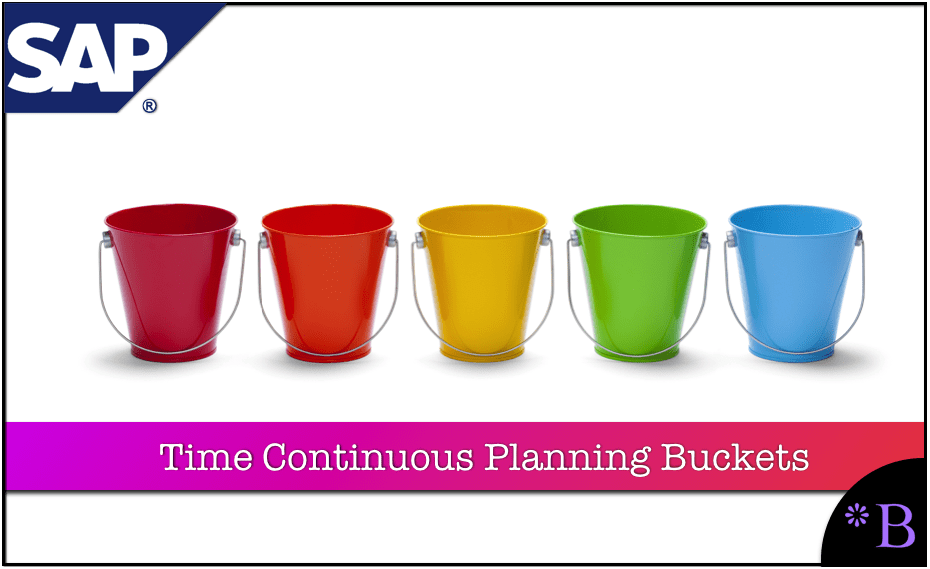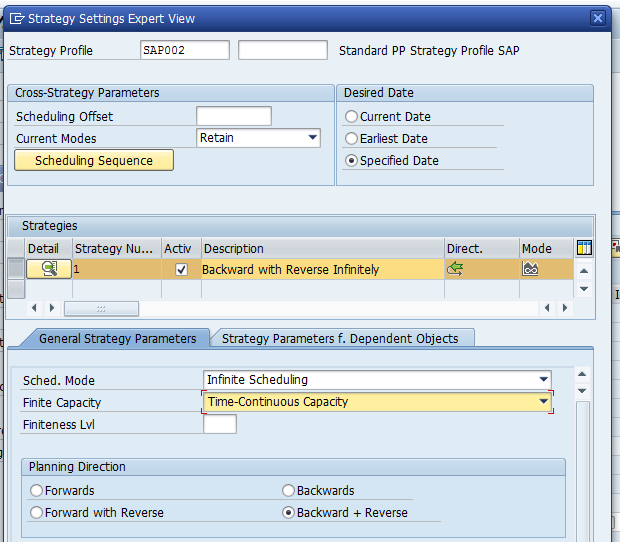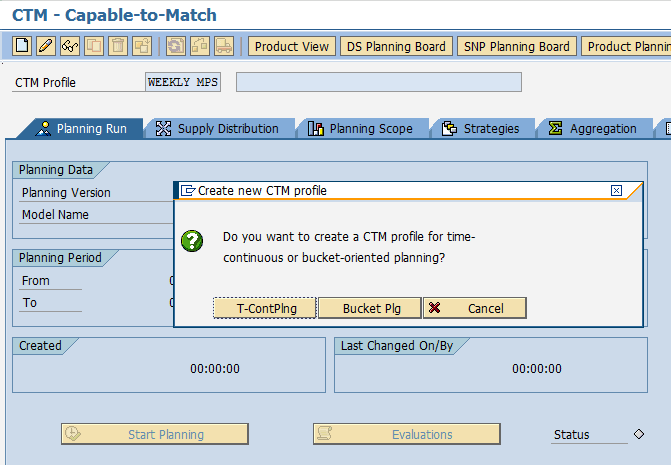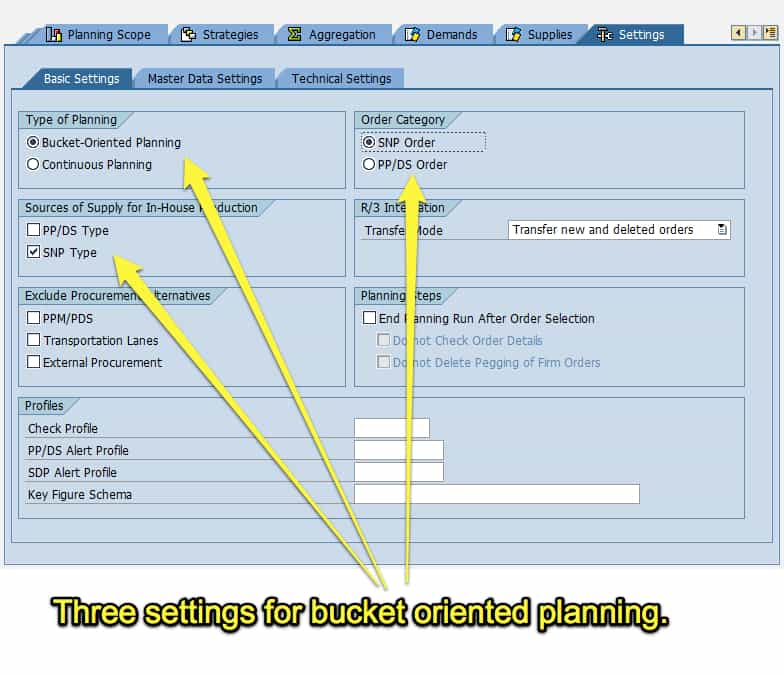How to Understand Bucket Oriented Planning in CTM and PP/DS
Executive Summary
- Time continuous and bucket planning can be performed in CTM and PP/DS.
- We cover the settings necessary for both the CTM Profile and the resources when continuous planning is used.
- Orders can be converted from both SNP and PP/DS planned orders.

Introduction to Time Continuous Planning
CTM can plan with bucket or time continuous planning. These are different levels of detail in planning that use different PPM and PDSs. It is important to determine the correct time planning type within CTM and PP/DS. But of course, when both are implemented at a company, it is also essential to integrate the two modules’ time planning settings. Time continuous planning is applied to PP/DS PPMs and PDSs and provides the highest detail within APO. On the other hand, Bucket oriented planning uses the SNP PPM or PDS, which is more abstracted.
Our References for This Article
If you want to see our references for this article and other related Brightwork articles, see this link.
Notice of Lack of Financial Bias: We have no financial ties to SAP or any other entity mentioned in this article.
- This is published by a research entity, not some lowbrow entity that is part of the SAP ecosystem.
- Second, no one paid for this article to be written, and it is not pretending to inform you while being rigged to sell you software or consulting services. Unlike nearly every other article you will find from Google on this topic, it has had no input from any company's marketing or sales department. As you are reading this article, consider how rare this is. The vast majority of information on the Internet on SAP is provided by SAP, which is filled with false claims and sleazy consulting companies and SAP consultants who will tell any lie for personal benefit. Furthermore, SAP pays off all IT analysts -- who have the same concern for accuracy as SAP. Not one of these entities will disclose their pro-SAP financial bias to their readers.
Most Cases with PP/DS
In most cases with PP/DS, Time Continuous Capacity will be used — the exception to this is if the company wants to perform block planning or perform characteristic dependent planning (CDP). Both block planning and CDP add considerable trickiness to the implementation. Therefore, the question that will often arise if these features should be added later after more basic planning has been mastered. This is set in PP/DS in several places, but one example is shown below:

Here within the Strategy Settings Expert View, which is enabled here from within the Strategy Button of the Create Order dialog box, we can see the Finite Capacity field is set to Time Continuous Capacity. This setting determines which capacity of the resource is to be used for finite scheduling.
Resource Settings and What This Means for Time Continuous Versus Bucket Planning
Different resource types, some like single-mixed and multi-mixed, can be set up that can be used by both SNP and PP/DS. However, how the resources are used can change in SNP depending upon the setting. Therefore, and as is shown from a quote further on in this article, both time continuous and bucket oriented planning can use mixed resources.
“If you want to consider the resource loads caused by PP/DS orders in SNP planning, and adjust the SNP planning accordingly, you must use mixed resources (single-mixed resources or multimixed resources). In mixed resources, you define the bucket capacity for period-oriented planning in SNP and the time-continuous capacity for time-continuous planning in PP/DS. An SNP order utilizes the bucket capacity of a mixed resource and a PP/DS order utilizes the time-continuous capacity of a mixed resource. For SNP planning, the amount of bucket capacity utilized by PP/DS orders is displayed as an aggregated capacity requirement. SNP planning can therefore take account of the PP/DS orders. For PP/DS planning, the time-continuous capacity used by SNP orders is not displayed.” – SNP Help
The system can automatically derive the bucket capacity of a mixed resource from the time-continuous capacity. Since you do not plan with so much detail in SNP, you do not use sequence-dependent setup times. You can reduce the bucket capacity derived using a loss factor. You obtain such a buffer for detailed planning in PP/DS.
“For single activity resources, multi activity resources and calendar resources or for the available time continuous capacity resources of mixed resources always enter a rate of resource utilization of 100% and a break duration of 00:00:00. Otherwise liveCache determines a different duration than CTM planning does for the corresponding activities. This may cause the system to fulfill the demand too late.
CTM always prefers to plan activities overlapping on multi-activity resources and does not support the synchronization of activities. Ensure that use the No Synchronization setting in the resource master on the Planning Parameters tab page under SyncStart. Otherwise the SAP liveCache executes a synchronization for the corresponding activities.” – SAP Help
Conversion of SNP Planned Orders to PP/DS Planned Orders
The PP/DS orders that CTM creates can be used without conversion when time-continuous planning is used in CTM. This is described in the quotation below:
“If you’re working with long-term, rough cut finite capacity planning, then using the SNP bucket mode is more appropriate. For short-term production planning, using CTM in PP/DS mode is better because the CTM created PP/DS orders can be used in PP/DS for setup optimization without order conversion from SNP order type to PP/DS order type. Planning in time-continuous mode requires using PP/DS PPM and CTM PDS with single activity, multi activity, or mixed resource types. Time continuous PP/DS planning is used in CTM for scheduling the resources with exact start and end times up to a second.”
Interestingly, mixed resources can be used easily by SNP because they have both a bucket and a time-continuous definition.
“Mixed resources have both the SNP bucket and PP/DS time-continuous capacity definition. CTM planning can use mixed resources for planning. When planning in PP/DS mode, CTM uses the time-continuous capacity as the primary capacity for finite planning. The bucket capacity is calculated for the scheduled activity to keep the time-continuous and bucket continuous capacity requirement consistent. On the other hand, when planning in SNP mode using mixed resources, the bucket capacity is used for finite planning, but time-continuous capacity isn’t calculated.” – CTM Book by SAP Press
Therefore, if a CTM Profile is required to process time-continuous for a month or two, and then process in buckets oriented planning mode, it often makes sense to break the planning horizon up with two identical CTM Profiles except for the time setting and which PPMs and PDSs are used (SNP for bucket oriented and PP/DS for time-continuous)
CTM Profile Settings
This is in the settings tab under Basic Settings. In fact, as soon as you create a CTM Profile, it asks you if the setting should be time continuous or bucket oriented, as is shown in the screen shown below:

 Several CTM settings relate to this:
Several CTM settings relate to this:
Time Continuous Planning:
Resource type used are single-activity resources, multi-activity resources, calendar resources, and mixed resources. Pre requisites:
- “Planning type- Continuous planning (discussed above)
- Source of Supply for in-house production, type PP/DS, (discussed below)
- PPM or PDS used of type PPDS (discussed below)
- For order creation – select the Order category as PPDS. (discussed below)” – SAP Community Network – Nanda Kumar
Bucket Oriented Planning:
Resources used are Bucket resources and Mixed resources. (not single activity and multi-activity)
- “Planning type- Bucket oriented
- SOS-type SNP
- PPM or PDS of type SNP
- For order creation, select Order category as SNP.” – SAP Community Network – Nanda Kumar
Conclusion
The connection between resource type and the planning time setting (time-continuous or bucket) is quite confusing in SAP. The planning time setting determines at what level of detail the planning is desired to be in. Longer range planning should be set to bucket oriented, which means that it uses SNP PPMs or PDSs. Shorter range planning, where the detail of the resources is necessary for a more accurate plan, promotes time-continuous planning, which means using PP/DS PPMs or PDSs.